https://github.com/jina-ai/clip-as-service
🏄 Scalable embedding, reasoning, ranking for images and sentences with CLIP
https://github.com/jina-ai/clip-as-service
bert bert-as-service clip-as-service clip-model cross-modal-retrieval cross-modality deep-learning image2vec multi-modality neural-search onnx openai pytorch sentence-encoding sentence2vec
Last synced: 7 months ago
JSON representation
🏄 Scalable embedding, reasoning, ranking for images and sentences with CLIP
- Host: GitHub
- URL: https://github.com/jina-ai/clip-as-service
- Owner: jina-ai
- License: other
- Created: 2018-11-12T10:48:50.000Z (about 7 years ago)
- Default Branch: main
- Last Pushed: 2024-01-23T10:33:43.000Z (almost 2 years ago)
- Last Synced: 2025-05-08T22:19:08.759Z (7 months ago)
- Topics: bert, bert-as-service, clip-as-service, clip-model, cross-modal-retrieval, cross-modality, deep-learning, image2vec, multi-modality, neural-search, onnx, openai, pytorch, sentence-encoding, sentence2vec
- Language: Python
- Homepage: https://clip-as-service.jina.ai
- Size: 27.4 MB
- Stars: 12,660
- Watchers: 223
- Forks: 2,076
- Open Issues: 302
-
Metadata Files:
- Readme: README.md
- Changelog: CHANGELOG.md
- License: LICENSE
Awesome Lists containing this project
- Awesome-LLM-Productization - clip-as-service - a low-latency high-scalability service for embedding images and text. It can be easily integrated as a microservice into neural search solutions (Python based, Apache 2); (Models and Tools / Embeddings)
- awesome-llmops - Clip-as-a-service - ai/clip-as-service.svg?style=flat-square) | (Serving / Large Model Serving)
- StarryDivineSky - jina-ai/clip-as-service
- awesome-production-machine-learning - CLIP-as-service - ai/clip-as-service.svg?style=social) - CLIP-as-service is a low-latency high-scalability service for embedding images and text. It can be easily integrated as a microservice into neural search solutions. (Neural Search and Retrieval)
README
CLIP-as-service is a low-latency high-scalability service for embedding images and text. It can be easily integrated as a microservice into neural search solutions.
⚡ **Fast**: Serve CLIP models with TensorRT, ONNX runtime and PyTorch w/o JIT with 800QPS[*]. Non-blocking duplex streaming on requests and responses, designed for large data and long-running tasks.
🫐 **Elastic**: Horizontally scale up and down multiple CLIP models on single GPU, with automatic load balancing.
🐥 **Easy-to-use**: No learning curve, minimalist design on client and server. Intuitive and consistent API for image and sentence embedding.
👒 **Modern**: Async client support. Easily switch between gRPC, HTTP, WebSocket protocols with TLS and compression.
🍱 **Integration**: Smooth integration with neural search ecosystem including [Jina](https://github.com/jina-ai/jina) and [DocArray](https://github.com/jina-ai/docarray). Build cross-modal and multi-modal solutions in no time.
[*] with default config (single replica, PyTorch no JIT) on GeForce RTX 3090.
### Text & image embedding
via HTTPS 🔐
via gRPC 🔐⚡⚡
```bash
curl \
-X POST https://-http.wolf.jina.ai/post \
-H 'Content-Type: application/json' \
-H 'Authorization: ' \
-d '{"data":[{"text": "First do it"},
{"text": "then do it right"},
{"text": "then do it better"},
{"uri": "https://picsum.photos/200"}],
"execEndpoint":"/"}'
```
```python
# pip install clip-client
from clip_client import Client
c = Client(
'grpcs://-grpc.wolf.jina.ai',
credential={'Authorization': ''},
)
r = c.encode(
[
'First do it',
'then do it right',
'then do it better',
'https://picsum.photos/200',
]
)
print(r)
```
### Visual reasoning
There are four basic visual reasoning skills: object recognition, object counting, color recognition, and spatial relation understanding. Let's try some:
> You need to install [`jq` (a JSON processor)](https://stedolan.github.io/jq/) to prettify the results.
Image
via HTTPS 🔐

```bash
curl \
-X POST https://-http.wolf.jina.ai/post \
-H 'Content-Type: application/json' \
-H 'Authorization: ' \
-d '{"data":[{"uri": "https://picsum.photos/id/1/300/300",
"matches": [{"text": "there is a woman in the photo"},
{"text": "there is a man in the photo"}]}],
"execEndpoint":"/rank"}' \
| jq ".data[].matches[] | (.text, .scores.clip_score.value)"
```
gives:
```
"there is a woman in the photo"
0.626907229423523
"there is a man in the photo"
0.37309277057647705
```

```bash
curl \
-X POST https://-http.wolf.jina.ai/post \
-H 'Content-Type: application/json' \
-H 'Authorization: ' \
-d '{"data":[{"uri": "https://picsum.photos/id/133/300/300",
"matches": [
{"text": "the blue car is on the left, the red car is on the right"},
{"text": "the blue car is on the right, the red car is on the left"},
{"text": "the blue car is on top of the red car"},
{"text": "the blue car is below the red car"}]}],
"execEndpoint":"/rank"}' \
| jq ".data[].matches[] | (.text, .scores.clip_score.value)"
```
gives:
```
"the blue car is on the left, the red car is on the right"
0.5232442617416382
"the blue car is on the right, the red car is on the left"
0.32878655195236206
"the blue car is below the red car"
0.11064132302999496
"the blue car is on top of the red car"
0.03732786327600479
```

```bash
curl \
-X POST https://-http.wolf.jina.ai/post \
-H 'Content-Type: application/json' \
-H 'Authorization: ' \
-d '{"data":[{"uri": "https://picsum.photos/id/102/300/300",
"matches": [{"text": "this is a photo of one berry"},
{"text": "this is a photo of two berries"},
{"text": "this is a photo of three berries"},
{"text": "this is a photo of four berries"},
{"text": "this is a photo of five berries"},
{"text": "this is a photo of six berries"}]}],
"execEndpoint":"/rank"}' \
| jq ".data[].matches[] | (.text, .scores.clip_score.value)"
```
gives:
```
"this is a photo of three berries"
0.48507222533226013
"this is a photo of four berries"
0.2377079576253891
"this is a photo of one berry"
0.11304923892021179
"this is a photo of five berries"
0.0731358453631401
"this is a photo of two berries"
0.05045759305357933
"this is a photo of six berries"
0.04057715833187103
```
## [Documentation](https://clip-as-service.jina.ai)
## Install
CLIP-as-service consists of two Python packages `clip-server` and `clip-client` that can be installed _independently_. Both require Python 3.7+.
### Install server
Pytorch Runtime ⚡
ONNX Runtime ⚡⚡
TensorRT Runtime ⚡⚡⚡
```bash
pip install clip-server
```
```bash
pip install "clip-server[onnx]"
```
```bash
pip install nvidia-pyindex
pip install "clip-server[tensorrt]"
```
You can also [host the server on Google Colab](https://clip-as-service.jina.ai/hosting/colab/), leveraging its free GPU/TPU.
### Install client
```bash
pip install clip-client
```
### Quick check
You can run a simple connectivity check after install.
C/S
Command
Expect output
Server
```bash
python -m clip_server
```

Client
```python
from clip_client import Client
c = Client('grpc://0.0.0.0:23456')
c.profile()
```

You can change `0.0.0.0` to the intranet or public IP address to test the connectivity over private and public network.
## Get Started
### Basic usage
1. Start the server: `python -m clip_server`. Remember its address and port.
2. Create a client:
```python
from clip_client import Client
c = Client('grpc://0.0.0.0:51000')
```
3. To get sentence embedding:
```python
r = c.encode(['First do it', 'then do it right', 'then do it better'])
print(r.shape) # [3, 512]
```
4. To get image embedding:
```python
r = c.encode(['apple.png', # local image
'https://clip-as-service.jina.ai/_static/favicon.png', # remote image
'data:image/gif;base64,R0lGODlhEAAQAMQAAORHHOVSKudfOulrSOp3WOyDZu6QdvCchPGolfO0o/XBs/fNwfjZ0frl3/zy7////wAAAAAAAAAAAAAAAAAAAAAAAAAAAAAAAAAAAAAAAAAAAAAAAAAAAAAAAAAAAAAAACH5BAkAABAALAAAAAAQABAAAAVVICSOZGlCQAosJ6mu7fiyZeKqNKToQGDsM8hBADgUXoGAiqhSvp5QAnQKGIgUhwFUYLCVDFCrKUE1lBavAViFIDlTImbKC5Gm2hB0SlBCBMQiB0UjIQA7']) # in image URI
print(r.shape) # [3, 512]
```
More comprehensive server and client user guides can be found in the [docs](https://clip-as-service.jina.ai/).
### Text-to-image cross-modal search in 10 lines
Let's build a text-to-image search using CLIP-as-service. Namely, a user can input a sentence and the program returns matching images. We'll use the [Totally Looks Like](https://sites.google.com/view/totally-looks-like-dataset) dataset and [DocArray](https://github.com/jina-ai/docarray) package. Note that DocArray is included within `clip-client` as an upstream dependency, so you don't need to install it separately.
#### Load images
First we load images. You can simply pull them from Jina Cloud:
```python
from docarray import DocumentArray
da = DocumentArray.pull('ttl-original', show_progress=True, local_cache=True)
```
or download TTL dataset, unzip, load manually
Alternatively, you can go to [Totally Looks Like](https://sites.google.com/view/totally-looks-like-dataset) official website, unzip and load images:
```python
from docarray import DocumentArray
da = DocumentArray.from_files(['left/*.jpg', 'right/*.jpg'])
```
The dataset contains 12,032 images, so it may take a while to pull. Once done, you can visualize it and get the first taste of those images:
```python
da.plot_image_sprites()
```

#### Encode images
Start the server with `python -m clip_server`. Let's say it's at `0.0.0.0:51000` with `GRPC` protocol (you will get this information after running the server).
Create a Python client script:
```python
from clip_client import Client
c = Client(server='grpc://0.0.0.0:51000')
da = c.encode(da, show_progress=True)
```
Depending on your GPU and client-server network, it may take a while to embed 12K images. In my case, it took about two minutes.
Download the pre-encoded dataset
If you're impatient or don't have a GPU, waiting can be Hell. In this case, you can simply pull our pre-encoded image dataset:
```python
from docarray import DocumentArray
da = DocumentArray.pull('ttl-embedding', show_progress=True, local_cache=True)
```
#### Search via sentence
Let's build a simple prompt to allow a user to type sentence:
```python
while True:
vec = c.encode([input('sentence> ')])
r = da.find(query=vec, limit=9)
r[0].plot_image_sprites()
```
#### Showcase
Now you can input arbitrary English sentences and view the top-9 matching images. Search is fast and instinctive. Let's have some fun:
"a happy potato"
"a super evil AI"
"a guy enjoying his burger"
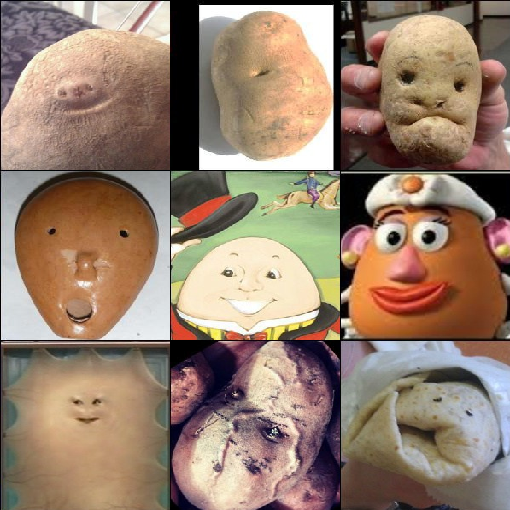

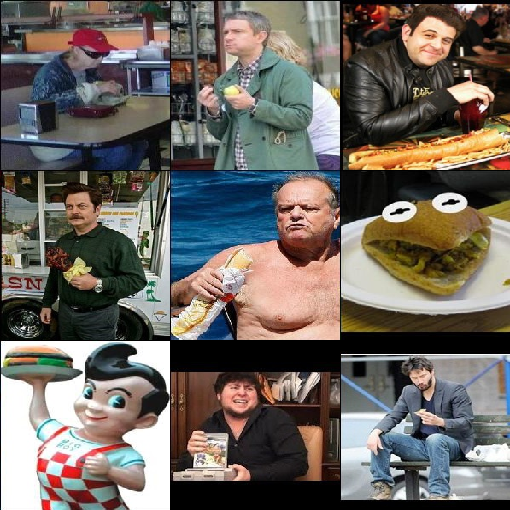
"professor cat is very serious"
"an ego engineer lives with parent"
"there will be no tomorrow so lets eat unhealthy"
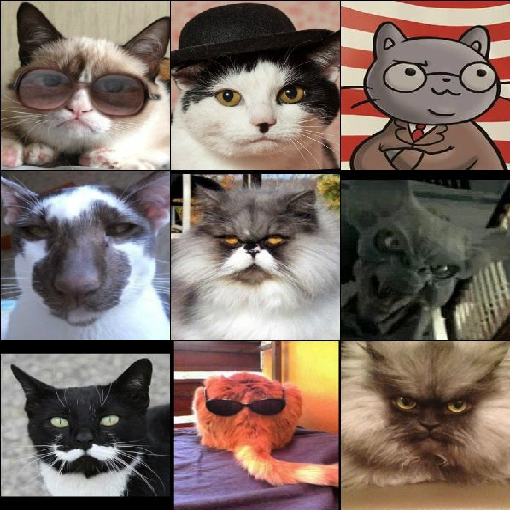
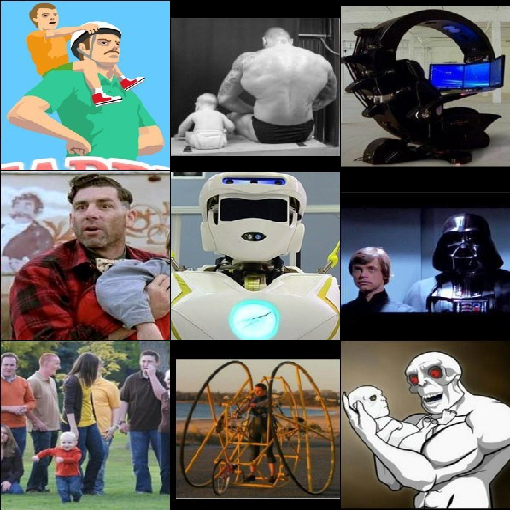
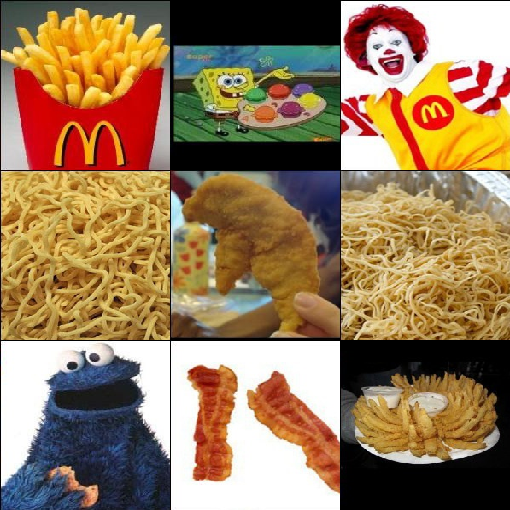
Let's save the embedding result for our next example:
```python
da.save_binary('ttl-image')
```
### Image-to-text cross-modal search in 10 Lines
We can also switch the input and output of the last program to achieve image-to-text search. Precisely, given a query image find the sentence that best describes the image.
Let's use all sentences from the book "Pride and Prejudice".
```python
from docarray import Document, DocumentArray
d = Document(uri='https://www.gutenberg.org/files/1342/1342-0.txt').load_uri_to_text()
da = DocumentArray(
Document(text=s.strip()) for s in d.text.replace('\r\n', '').split('.') if s.strip()
)
```
Let's look at what we got:
```python
da.summary()
```
```text
Documents Summary
Length 6403
Homogenous Documents True
Common Attributes ('id', 'text')
Attributes Summary
Attribute Data type #Unique values Has empty value
──────────────────────────────────────────────────────────
id ('str',) 6403 False
text ('str',) 6030 False
```
#### Encode sentences
Now encode these 6,403 sentences, it may take 10 seconds or less depending on your GPU and network:
```python
from clip_client import Client
c = Client('grpc://0.0.0.0:51000')
r = c.encode(da, show_progress=True)
```
Download the pre-encoded dataset
Again, for people who are impatient or don't have a GPU, we have prepared a pre-encoded text dataset:
```python
from docarray import DocumentArray
da = DocumentArray.pull('ttl-textual', show_progress=True, local_cache=True)
```
#### Search via image
Let's load our previously stored image embedding, randomly sample 10 image Documents, then find top-1 nearest neighbour of each.
```python
from docarray import DocumentArray
img_da = DocumentArray.load_binary('ttl-image')
for d in img_da.sample(10):
print(da.find(d.embedding, limit=1)[0].text)
```
#### Showcase
Fun time! Note, unlike the previous example, here the input is an image and the sentence is the output. All sentences come from the book "Pride and Prejudice".





Besides, there was truth in his looks
Gardiner smiled
what’s his name
By tea time, however, the dose had been enough, and Mr
You do not look well





“A gamester!” she cried
If you mention my name at the Bell, you will be attended to
Never mind Miss Lizzy’s hair
Elizabeth will soon be the wife of Mr
I saw them the night before last
### Rank image-text matches via CLIP model
From `0.3.0` CLIP-as-service adds a new `/rank` endpoint that re-ranks cross-modal matches according to their joint likelihood in CLIP model. For example, given an image Document with some predefined sentence matches as below:
```python
from clip_client import Client
from docarray import Document
c = Client(server='grpc://0.0.0.0:51000')
r = c.rank(
[
Document(
uri='.github/README-img/rerank.png',
matches=[
Document(text=f'a photo of a {p}')
for p in (
'control room',
'lecture room',
'conference room',
'podium indoor',
'television studio',
)
],
)
]
)
print(r['@m', ['text', 'scores__clip_score__value']])
```
```text
[['a photo of a television studio', 'a photo of a conference room', 'a photo of a lecture room', 'a photo of a control room', 'a photo of a podium indoor'],
[0.9920725226402283, 0.006038925610482693, 0.0009973491542041302, 0.00078492151806131, 0.00010626466246321797]]
```
One can see now `a photo of a television studio` is ranked to the top with `clip_score` score at `0.992`. In practice, one can use this endpoint to re-rank the matching result from another search system, for improving the cross-modal search quality.


### Rank text-image matches via CLIP model
In the [DALL·E Flow](https://github.com/jina-ai/dalle-flow) project, CLIP is called for ranking the generated results from DALL·E. [It has an Executor wrapped on top of `clip-client`](https://github.com/jina-ai/dalle-flow/blob/main/executors/rerank/executor.py), which calls `.arank()` - the async version of `.rank()`:
```python
from clip_client import Client
from jina import Executor, requests, DocumentArray
class ReRank(Executor):
def __init__(self, clip_server: str, **kwargs):
super().__init__(**kwargs)
self._client = Client(server=clip_server)
@requests(on='/')
async def rerank(self, docs: DocumentArray, **kwargs):
return await self._client.arank(docs)
```
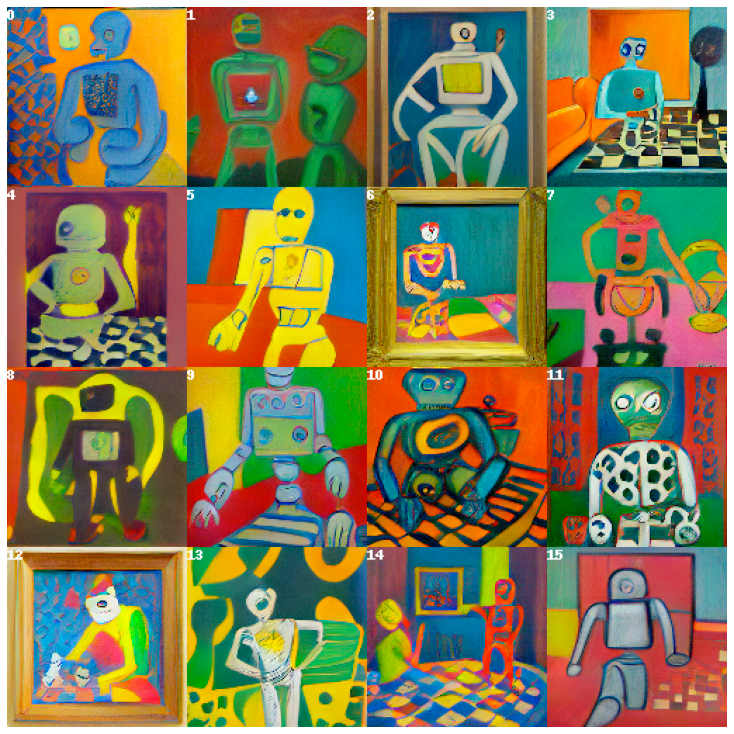
Intrigued? That's only scratching the surface of what CLIP-as-service is capable of. [Read our docs to learn more](https://clip-as-service.jina.ai).
## Support
- Join our [Discord community](https://discord.jina.ai) and chat with other community members about ideas.
- Watch our [Engineering All Hands](https://youtube.com/playlist?list=PL3UBBWOUVhFYRUa_gpYYKBqEAkO4sxmne) to learn Jina's new features and stay up-to-date with the latest AI techniques.
- Subscribe to the latest video tutorials on our [YouTube channel](https://youtube.com/c/jina-ai)
## Join Us
CLIP-as-service is backed by [Jina AI](https://jina.ai) and licensed under [Apache-2.0](./LICENSE). [We are actively hiring](https://jobs.jina.ai) AI engineers, solution engineers to build the next neural search ecosystem in open-source.



-brightgreen?style=flat-square&logo=googlecolab&&logoColor=white)